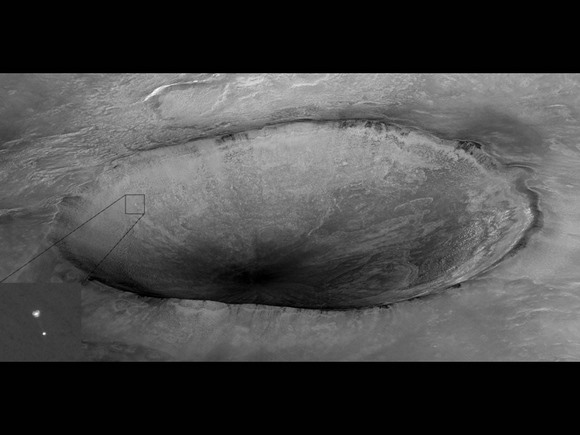Remember the amazing image that the HiRISE Camera on the Mars Reconnaissance Orbiter captured of the Phoenix Lander as it descended to Mars’ surface via parachute back on May 25? Well, the HiRISE scientists have done a little more processing of the image, and have turned up an additional detail they didn’t see at first: Phoenix’s heat shield. The heat shield, which had been jettisons just after parachute deployment, can be seen falling toward the surface. You have to look really, really close to see it. But that’s what these HiRISE folks do. It was incredible that they found the lander with the parachute in the image (go see the big, huge image they had to hunt for it HERE) and these guys get the eagle eyes of the year award for finding the heat shield.
HiRISE made history by taking the first image of a spacecraft as it descended toward the surface of another planetary body. Here’s the image again:

The image shows NASA’s Phoenix Mars Lander when the spacecraft was still tucked inside its aeroshell, suspended from its parachute, at 4:36 p.m. Pacific Daylight Time on landing day. Although Phoenix appears to be descending into an impressive impact crater, it actually landed 20 kilometers, or 12 miles, away.
Mars Reconnaissance Orbiter was about 760 kilometers, or 475 miles, away when it pointed the HiRISE camera obliquely toward the descending Phoenix lander. The camera viewed through the hazy Martian atmosphere at an angle 26 degrees above the horizon when it took the image. The 10-meter, or 30-foot, wide parachute was fully inflated. Even the lines connecting the parachute and aeroshell are visible, appearing bright against the darker, but fully illuminated Martian surface.
In further analyzing the image, the HiRISE team discovered a small, dark dot located below the lander.
Phoenix was equipped with a heat shield that protected the lander from burning up when it entered Mars’ atmosphere and quickly decelerated because of friction. Phoenix discarded its heat shield after it deployed its parachute.
“Given the timing of the image and of the release of the heat shield, as well as the size and the darkness of the spot compared to any other dark spot in the vicinity, we conclude that HiRISE also captured Phoenix’s heat shield in freefall,” said HiRISE principal investigator Alfred McEwen.
The multigigabyte HiRISE image also includes a portion recorded by red, blue-green and infrared detectors, and scientists have processed that color part of the image.
HiRISE’s color bands missed the Phoenix spacecraft but do show frost or ice in the bowl of the relatively recent, 10-kilometer (6-mile) wide impact crater unofficially called “Heimdall.” The frost shows up as blue in the false-color HiRISE data, and is visible on the right wall within the crater.
The HiRISE camera doesn’t distinguish between carbon dioxide frost and water frost, but another instrument called CRISM on the Mars Reconnaissance Orbiter could.
News Source: SpaceRef


Good gravy, that’s gravy,
I wish the pic with the heat sheild pointed out led to a bigger pic.
Not that I wish to be disrespectful to the eagle eyed scientist who spotted this but given that we know where the lander landed and it’s Mars entry trajectory and exactly where the HIRISE was pointed when it took the photo surely you could get pretty close with some simple trig.
Here’s the largest version I could find of the HrRise site. You can find the heatshield for yourself.
http://hirise.lpl.arizona.edu/images/2008/details/cut/PSP_008579_9020_cut_b.jpg